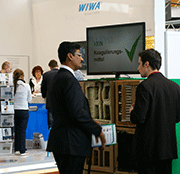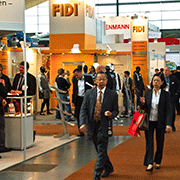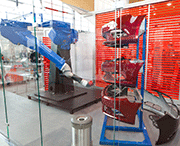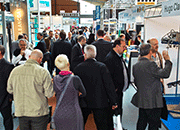E-Archive
Articles
in Vol. 15 - January Issue - Year 2014
PaintExpo - Answers for Demanding Coating Requirements




Ever greater demands are being placed on surfaces, and thus, on coating technologies as well. On the one hand, efficient use of resources, individuality, and environmental compatibility are decisive in this respect. On the other hand, new ranges of applications, quality and flexibility, play a significant role as well. With numerous new and further developments, the exhibitors at the 5th PaintExpo will provide answers on how these challenges can be met. The leading international trade fair with more than 400 exhibitors will take place at the exhibition centre in Karlsruhe from the 8th through the 11th of April, 2014.
Whether motor vehicles, consumer goods, machinery and equipment, consumer goods, machinery and equipment, communications, electronics, architecture, medical technology or energy are concerned ¡V there's hardly an industry sector in which coating technology is not ever-present. A great variety of functional and decorative requirements needs to be fulfilled for various surfaces. In addition, it's always important to apply coatings or paint using as little material and as few resources as possible, as ecologically as possible, and with the best possible quality ¡V regardless of the base material.
Trends in Efficient Coating
The exhibitors at PaintExpo offer new solutions and further developments to this end, throughout the entire process sequence for liquid painting, powder coating, and coil coating. For instance, where the pre-treatment of metallic substrates is concerned, iron phosphating, which becomes effective at temperatures of as low as 30 to 35¢X C instead of 40 to 60¢X C as well as nano-ceramic systems, are becoming more and more prevalent. In the meantime, products based on renewable raw materials are also available for the pre-treatment and cleaning of components made of steel, iron, and aluminium. Alternative processes such as snow blasting and plasma cleaning are also on the advance for the pre-treatment of plastic parts.
Paints with Optimised Function
In the field of painting, there's a trend towards systems that fulfil decorative as well as functional requirements. For solvent-based paints and clear coats used on metals, plastics and wood, additives are available that provide the paint with, amongst other things, antimicrobial characteristics. These are based on organometallic substances, which have an ionising effect. These substances are also being used in newly developed powdered enamels with antimicrobial effect. For components used in, for example, construction and farm machinery, as well as in outdoor applications, requirements have become stricter for corrosion protection and resistance to UV radiation and weathering. These requirements can be fulfilled effectively and ecologically with an epoxy-based primer powder that is free of zinc and heavy metals. It fulfils corrosion protection requirements up to C5-I lang, and can be painted over with powder coatings as well as liquid paints. The corrosion protection primer is offered as a solution that is ideally matched to the substrate to be coated (ferrous metals, substrates with sharp edges, castings). Another newly developed 2-layer powder coating solution for highly effective corrosion protection allows for coating without energy-intensive, intermediate cross-linking. Primer and topcoat are applied to the component using a powder-on-powder process based on tribotechnology, and both layers are subsequently cross-linked in a single step.
UV Technology On the Advance
The significance of UV technology continues to grow for plastic as well as metal parts, because more and more complex workpieces can be coated with the help of this method. UV curing takes place in an inert gas atmosphere, for which CO2 or nitrogen is used to reduce oxygen content. This prevents the radicals that are required for the polymerisation process from reacting with oxygen in the atmosphere, thus ruling out the possibility of a so-called oxygen inhibition. Curing can thus take place at larger intervals, and areas that are subjected to significantly less UV radiation are better cured as well. In addition to gas discharge tubes, LED radiators are also used for curing UV paints in the meantime.
Nitrogen Instead of Compressed Air
In the interest of material efficiency for the application of solvent, water-based and high-solid paints, alternative atomising gases are also being tested. The use of nitrogen allows for material savings ranging from 5% to 45%. Beyond this, a corresponding process that, in the meantime, has proven its worth in various series applications in the automotive industry, offers advantages with regard to painting quality, throughput, and system availability.
Innovations and further developments will await visitors throughout the entire exhibition programme at PaintExpo, which covers coating equipment, application systems and spray guns, liquid paints and powdered enamels, automation and conveyor technology, cleaning and pre-treatment, drying and curing, environmental technology, pneumatics, compressed air supply and exhaust purification, water treatment, recycling and disposal, accessories, measuring and test technology, quality assurance, paint stripping, job-shop coating, services and technical literature as well as identification, printing and packaging.
The WTT Expo trade fair for industrial heating and cooling technology and the HallTec trade fair for technical building equipment for industry and the commercial trades will take place concurrently with PaintExpo 2014 at the Karlsruhe Exhibition Centre.
For Information:
FairFair GmbH
Max-Eyth-Strasse 19
72644 Oberboihingen, Germany
Tel. +49.7022.60255 10
Fax +49.7022.60255 77
E-mail: info@paintexpo.de
www.paintexpo.com



























